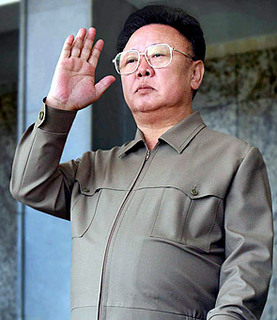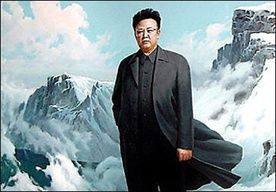Kim Jong-Il the Current Leader of North Korea.

Depending on who's records you believe, Kim Jong-Il was born on either February 16, 1941, in the USSR as say the Soviets, or on February 16, 1942, in North Korea as say the North Korean government, according to the Biography.com article "Kim Jong II Biography." BBC News article entitled "Profile: Kim Jong-Il," says that even upon birth, the leader of the northern communist state has always been clouded in mystery. This is due to North Korea's version of his birth; it says that when he was born in the country's tallest mountain, a double rainbow and golden star appeared in the sky (Profile). The other version, however, is much more simple; according to Biography.com, Jong-Il's father, Kim Il-Sung, was a commander in the Soviet Army during World War II, and therefore he could have easily been born in the USSR instead of in Korea.
Beyond his initial birth, more mystery surrounds his education. Official documents in North Korea state that he received his primary education entirely in Pyongyang from 1950 to 1960. However, it is crucial to point out that it was in those years that the Korean War was fought, and thus speculation leads to the idea that he was actually educated in China during the war, but of course there is no actual evidence of this (Biography). Thus, it can be seen that the beginnings of his life were in contrast to his father's, as he never had to fight for survival and was always well taken care of. His youth was rather utopian as opposed to his father's dystopian upbringings.
Beyond his initial birth, more mystery surrounds his education. Official documents in North Korea state that he received his primary education entirely in Pyongyang from 1950 to 1960. However, it is crucial to point out that it was in those years that the Korean War was fought, and thus speculation leads to the idea that he was actually educated in China during the war, but of course there is no actual evidence of this (Biography). Thus, it can be seen that the beginnings of his life were in contrast to his father's, as he never had to fight for survival and was always well taken care of. His youth was rather utopian as opposed to his father's dystopian upbringings.

From there, he then moved on to the Kim Il-Sung University in Pyongyang, and whilst still there joined the Korean Worker's party. He graduated in 1964 and quickly rose the ranks within the Worker's party. He was appointed positions in which he could promote his father's policies, push out any other ideologies, and increase the party's control of the military. It was also in this time that he was the head of propaganda and censorship within North Korean. It is therefore said that because of him, the Democratic People's Republic of Korea was brought into a new era of fine arts based on the ideologies set forth by his father (Biography).
Biography.com goes on to say that throughout the 1970's, Kim Il-Sung began grooming his son to become his successor. As Kim Jong-Il was granted more promotions, the state began to build a strong image of his as the true and only possible heir to the North Korean regime. In true dystopian fashion, the people were therefore unable to choose who would be Kim Il-Sung's successor, and in 1980, he was given control of several key positions within the government and the Korean Worker's party. However, it was not until 1991 that he assumed control over North Korea's army, thereby solidifying his succession (Biography).
On his father's death in 1994, Kim Jong-Il assumed the position of the chairman of the National Defense Commission, the state's highest leadership position (Biography). After this ,however, things did not fair so well for him. The economy began to nose dive, and as a result, Jong-Il initiated the Military First policy, which granted prioritization of national resources to the military (Biography). And so, while people were starving, the military was strong. This dystopian era of backwards priorities brought attempts by foreign governments to try and demilitarize the North Korean society. There were many attempts, and some looked promising, but as always, Kim Jong-Il eventually refuted and thus the Democratic People's Republic of Korea is the same as it was many years ago (Biography).
Biography.com goes on to say that throughout the 1970's, Kim Il-Sung began grooming his son to become his successor. As Kim Jong-Il was granted more promotions, the state began to build a strong image of his as the true and only possible heir to the North Korean regime. In true dystopian fashion, the people were therefore unable to choose who would be Kim Il-Sung's successor, and in 1980, he was given control of several key positions within the government and the Korean Worker's party. However, it was not until 1991 that he assumed control over North Korea's army, thereby solidifying his succession (Biography).
On his father's death in 1994, Kim Jong-Il assumed the position of the chairman of the National Defense Commission, the state's highest leadership position (Biography). After this ,however, things did not fair so well for him. The economy began to nose dive, and as a result, Jong-Il initiated the Military First policy, which granted prioritization of national resources to the military (Biography). And so, while people were starving, the military was strong. This dystopian era of backwards priorities brought attempts by foreign governments to try and demilitarize the North Korean society. There were many attempts, and some looked promising, but as always, Kim Jong-Il eventually refuted and thus the Democratic People's Republic of Korea is the same as it was many years ago (Biography).
In 2008, it was reported that Jong-Il had a stroke and his health is deteriorating rapidly. Now, it is said that he is grooming his youngest son, Kim Jong-Un to to be his successor. For a full biography, click here.
This video is a compilation found on Youtube.com that was made in order to provides a more in depth look at what life is like under the Kim Jong-Il regime. It is intended for a younger audience base, but utilizes video from National Geographic. The video concludes that as of right now, it is virtually impossible to get a completely accurate picture of what life is like in North Korea due to the country's lack of openness.
This video is a compilation found on Youtube.com that was made in order to provides a more in depth look at what life is like under the Kim Jong-Il regime. It is intended for a younger audience base, but utilizes video from National Geographic. The video concludes that as of right now, it is virtually impossible to get a completely accurate picture of what life is like in North Korea due to the country's lack of openness.
